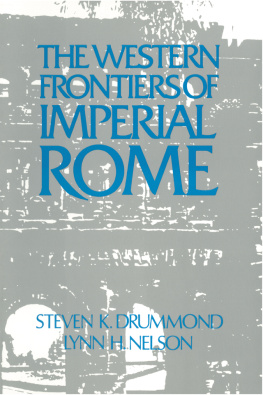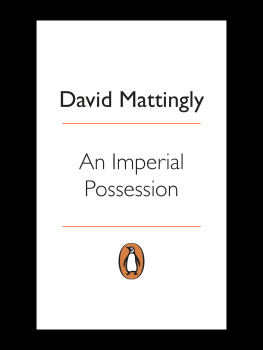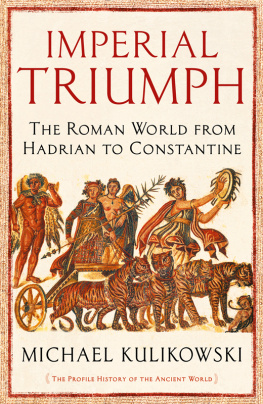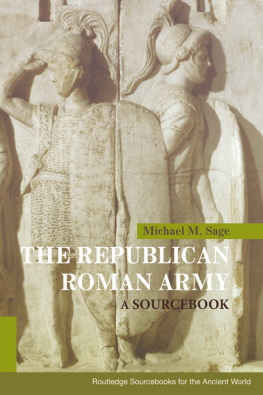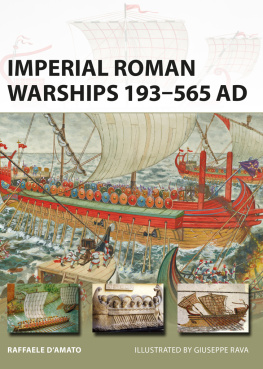OXFORD CLASSICAL MONOGRAPHS
Published under the supervision of a Committee of the Faculty of Classics
in the University of Oxford
The aim of the Oxford Classical Monograph series (which replaces the Oxford Classical and Philosophical Monographs) is to publish books based on the best theses on Greek and Latin literature, ancient history, and ancient philosophy examined by the Faculty Board of Classics.
Imperial Mines and Quarries in the Roman World
Organizational Aspects 27 BCAD 235
ALFRED MICHAEL HIRT


Great Clarendon Street, Oxford OX2 6DP
Oxford University Press is a department of the University of Oxford.
It furthers the Universitys objective of excellence in research, scholarship,
and education by publishing worldwide in
Oxford New York
Auckland Cape Town Dar es Salaam Hong Kong Karachi
Kuala Lumpur Madrid Melbourne Mexico City Nairobi
New Delhi Shanghai Taipei Toronto
With offices in
Argentina Austria Brazil Chile Czech Republic France Greece
Guatemala Hungary Italy Japan Poland Portugal Singapore
South Korea Switzerland Thailand Turkey Ukraine Vietnam
Oxford is a registered trade mark of Oxford University Press
in the UK and in certain other countries
Published in the United States
by Oxford University Press Inc., New York
Alfred Michael Hirt 2010
The moral rights of the author have been asserted
Database right Oxford University Press (maker)
First published 2010
All rights reserved. No part of this publication may be reproduced,
stored in a retrieval system, or transmitted, in any form or by any means,
without the prior permission in writing of Oxford University Press,
or as expressly permitted by law, or under terms agreed with the appropriate
reprographics rights organization. Enquiries concerning reproduction
outside the scope of the above should be sent to the Rights Department,
Oxford University Press, at the address above
You must not circulate this book in any other binding or cover
and you must impose the same condition on any acquirer
British Library Cataloguing in Publication Data
Data available
Library of Congress Cataloging in Publication Data
Library of Congress Control Number: 2009938800
Typeset by SPI Publisher Services, Pondicherry, India
Printed in Great Britain
on acid-free paper by
CPI Antony Rowe, Chippenham, Wiltshire
ISBN 9780199572878
1 3 5 7 9 10 8 6 4 2
Fr Mueter u Vater, Gotte u Gtti, fr e Michael u dr Heinz
Preface
Roman mines and quarries have emerged in recent years as a topic of study by scholars interested in the Roman economy. Archaeologists in particular have directed their attention to specific mining sites like Las Mdulas, Roia Montan, and Dolaucothi, or offered detailed analysis of quarrying sites such as Gebel Dokhan, Gebel Fatirah, or Chemtou. These archaeological studies set aside, numerous finds of Latin and Greek inscriptions on stone monuments, quarried items, ingots, or bronze tablets, as well as writing tablets, ostraca, and papyri provide additional insights but have been published disparately. The main aim of this study is to unite the various snippets of information with respect to their archaeological and historical context in order to gain an overview of various aspects of the internal organization of mining and quarrying ventures under imperial control and their place within the administrative framework of the Roman empire.
An initial version of this study was submitted as a DPhil thesis at Oxford University in 2004. The thesis as a whole was reworked in the following years in order to include additional material and completed in late 2007. The study owes much to numerous discussions with Michael A. Speidel who freely shared his profound insights into the workings of the Roman empire; and to Heinz E. Herzig who at the University of Berne created the ideal academic environment and supported this endeavour from the beginning. At Oxford, my supervisor Andrew Wilson pointed the reluctant ancient historian towards the relevancy of the archaeological data and offered superb advice on many of its aspects. Many more at Oxford contributed (knowingly or not) to the genesis of this study. Alan Bowman and David Mattingly provided helpful comments on the thesis and encouraged publication of the work, Alan taking on the timeconsuming task of correcting a draft version. Further thanks must go to J. J. Coulton and Nicholas Purcell, Bill Leadbetter, Adam Blow-Jacobsen, Michael Crawford, Peter Herz, Stefanie Martin-Kilcher, for advice and bits and pieces of helpful information. Caillan Davenport, Caroline Brehaut, Charlotte Walden, Lesley Cousins, and, last but not least, Oskar Kaelin, read the texts at different stages and improved it by eradicating various remnants of my Helvetic syntax. Galina Rusak and Colin Hughes helped me with the index and Kathleen Fearn and Abigail Coulson at OUP turned the submitted text into the typescript presented here. Any remaining mistakes are of course mine. Adam Blow-Jacobsens Mons Claudianus Ostraca graeca et latina IV (2009) was published too late to be included in this survey.
My stay at Oxford was made possible by generous grants by the Swiss National Fund, the Janggen-Pehn Stiftung in St Gallen, Switzerland, the Krmn-Stiftung of the University of Berne, Switzerland.
Finally, I would wish to thank my parents, the extended Hirt-Bolliger clan, and my friends who endured my gravamina and offered their encouragement and support.
A.M.H.
Contents
List of Illustrations
)
)
)
List of Abbreviations
AE | Annee Epigraphique. |
AIJ | V. Hoffiller and B. Saria, Antike Inschriften aus Jugoslawien, 1. Noricum und Pannonia Superior, Zagreb 1938. |
CBFIR | E. Schallmayer et al (eds.), Corpus der griechischen und lateinischen Beneficiarier-Inschriften des Rmischen Reiches, Stuttgart 1990. |
CIG | Corpus Inscriptionum Graecarum, Berlin 182877. |
CIL | Corpus Inscriptionum Latinarum. |
CILA | Corpus de Inscripciones Latinas de Andaluca, Sevilla. |
Corinth VIII/III | J. H. Kent, The Inscriptions 19261950 (Corinth 8/3), Princeton 1966. |
EAstorga | T. Maanes Perez, Epigrafia y numismatica de Astorga romana y su entorno (Acta Salmanticensia. Filosofia y Letras 134), Salamance 1982. |
Eph. ep. | Ephemeris epigraphica. Corpus inscriptionum Latinarum supplementum, Berlin 1, 18729, 190313. |
FIRA | Fontes iuris Romani anteiustiniani, Florentiae 19403. |
HEp | Hispania Epigraphica |
I. Akoris | . Bernand, Les Inscriptions Grecques et Latines dAkris, Cairo 1988. |
IDR | Inscriptiones Dacicae Romanae |
Next page


